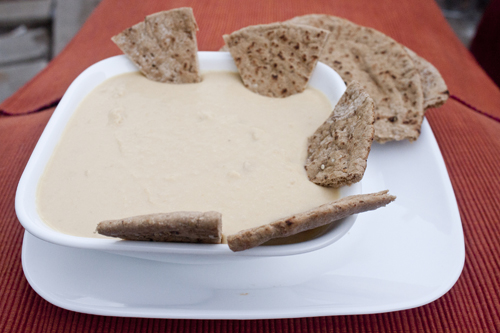January 23, 2013 — Originally published in the Nevada Appeal
Many, if not most, of my cooking stories and memories are attached to my time in Germany.
I was an au pair — a nanny with less pay and more responsibility who lives with the family.

Hummus is made much easier with either a blender or a food processor.
Before I flew across pond, I had cooked some on my own. I moved out of the dorms early because I loathed not being able to cook for myself.
As the au pair, I was in charge of cooking for a family of four and also for cooking for guests, visiting family and parties.
I had always toyed with idea of hummus before and as a kid my parents would buy it at the specialty grocery store and add garlic powder and lemon juice. The German family had a party coming up so I decided to dive in, head first.
I found out where one of the middle eastern stores was — beneath the train station, across the corner from the Asian store where I bought cilantro by the roots — and procured the key: tahini, or, sesame seed paste. I made sure the chickpeas soaked overnight, found the pressure cooker, keyed up the recipe and blended to my heart’s content.
The hummus was a hit, as were the whole-wheat pitas I made with the aid of a baking stone. Now that I’m back state-side, I can forego making the pita bread in favor of buying it but I still make the hummus. I love it so.
One of the creature comforts Americans take for granted in the kitchen is the mighty slow cooker, which I use any time I need to cook beans. In Germany, it was near impossible to find a slow cooker. The only option was to import and have a voltage downgrader to operate on Europe’s higher voltage.
One could use canned chickpeas, but, where’s the fun in that?
When it comes to hummus, I go heavy on the garlic because I can. The recipe has less garlic than I personally use. When I was in Germany, it was verboten to serve anything with garlic, unless the eaters didn’t have to go to work the next day. Even then, it was iffy.
When it comes to hummus, any number of adjuncts can be blended and added, chopped and added or even added whole. Artichoke hearts, bell peppers, roasted garlic, the list goes on.
I base my recipe size on eight ounces of tahini, which in ratio, calls for a (dry) pound of chickpeas. I buy the tahini from Trader Joe’s in the refrigerated section, near the hummus. There, it is labeled “Tahini Sauce.”One of the keys to using a blender to make the hummus is to add just enough liquid to the beans so they can easily be blended. Reserve some of the water the legumes are cooked in or, some of the water in the cans.
Another sticking point for hummus can be its texture, which is entirely dependent on the tastes of the cook. I prefer a rougher hummus, often times with a few whole chickpeas left in. For a creamier hummus, blend all the chickpeas at once. For a chunkier, blend only a portion fully, and partially blend or don’t blend, the rest.
INGREDIENTS
- 1 pound dry chickpeas (also called garbanzo beans) — around 7 cups cooked
- 8 ounces tahini
- 1 /3 cup lemon juice
- 2 tablespoons lime juice
- 3 tablespoons chopped garlic, more to taste
- Salt, to taste
- 1 /3 cup reserved chickpea cooking water
- Artichoke hearts (optional)
DIRECTIONS
1. Soak the chickpeas overnight in cold water, three times the quantity of water to chickpeas. Cook the chickpeas until tender, with a few dashes of salt. If made in a slow cooker, cook on low for at least five hours.
2. Drain the chickpeas, reserving 1/3 cup of the cooking water.
3. Add 2/3 of the chickpeas (or all, to make a creamier hummus) into a blender or food processor, along with the lemon juice. When blending, a little more liquid can help facilitate the process. Add a few tablespoons of cooking water as needed.
4. Add the tahini and continue blend until everything is mixed. Once the chickpeas blend with the tahini, the color should change to a lighter shade of yellow.
5. Decant the mixture into a mixing bowl and add into the blender the garlic, the lime juice and, if using, the artichoke hearts or other ingredients and blend.
6. Add the new mixture into the mixing bowl and stir until well combined.
7. Add salt, or garlic salt, to taste. Start with two teaspoons. Just enough salt will make the flavors of the hummus pop.
8. Add the rest of the chickpeas, either only briefly blended or whole, depending on texture desires.
9. Refrigerate or enjoy immediately. The hummus will get just a little bit better and thicken after it has been refrigerated.